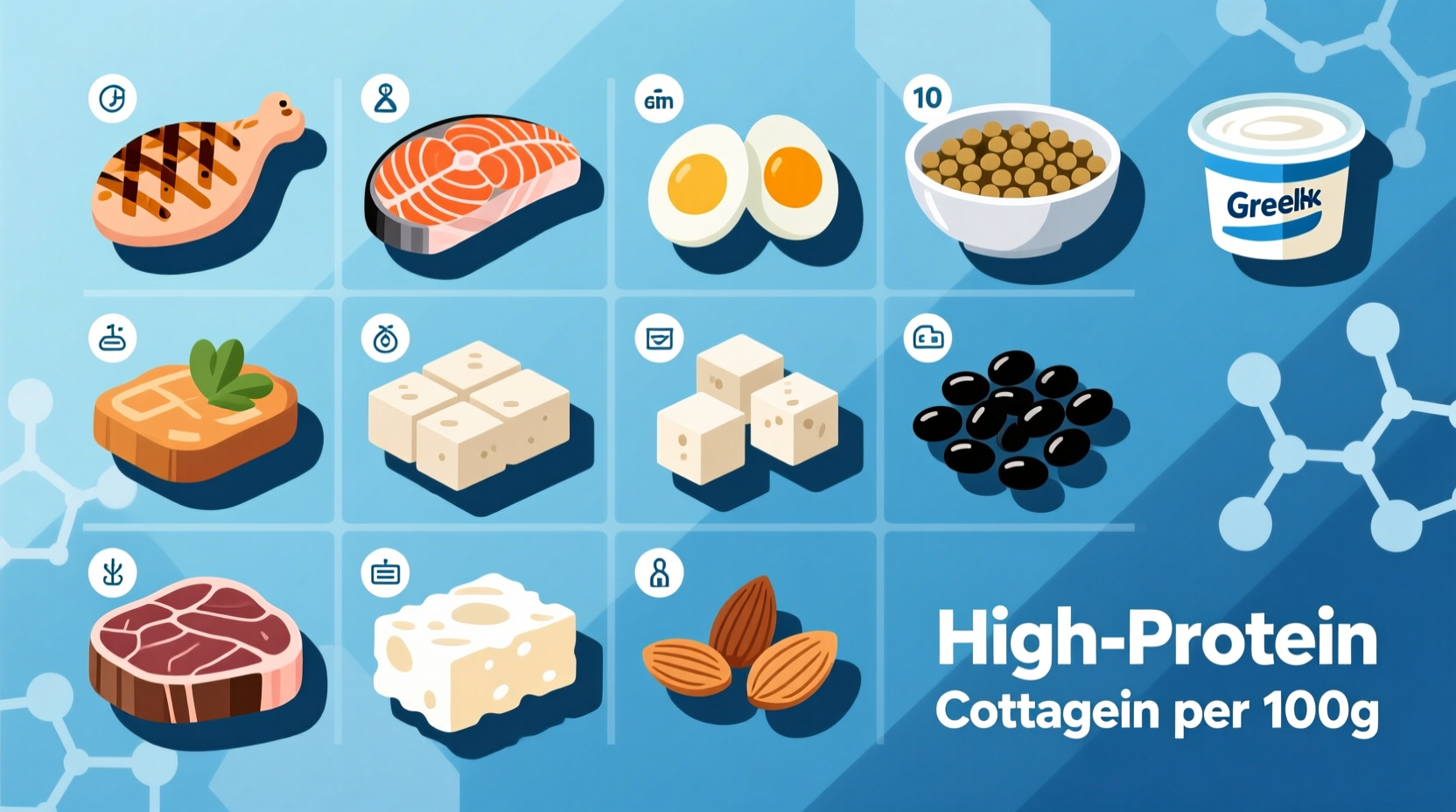Protein fuels muscle repair, supports immune function, and maintains metabolic health. The National Academy of Medicine recommends 0.8g of protein per kilogram of body weight daily for adults, though athletes and older adults often require more. Understanding which foods deliver maximum protein with minimal calories helps optimize dietary planning for fitness goals, weight management, or general wellness.
Why Protein Quality Matters
Not all proteins deliver equal benefits. Complete proteins contain all nine essential amino acids your body can't produce. Animal sources typically provide complete proteins, while most plant proteins require strategic pairing. The Protein Digestibility Corrected Amino Acid Score (PDCAAS), established by the Food and Agriculture Organization, measures protein quality on a scale from 0 to 1.0, with values above 0.7 considered high quality.
Top Animal-Based Protein Powerhouses
Animal proteins generally offer complete amino acid profiles with high bioavailability. These options deliver maximum protein per calorie:
| Food (per 100g) | Protein (g) | Calories | PDCAAS |
|---|---|---|---|
| Egg whites | 11.0 | 52 | 1.0 |
| Chicken breast | 31.0 | 165 | 1.0 |
| Tuna (canned) | 26.0 | 116 | 1.0 |
| Lean beef | 27.0 | 180 | 0.92 |
| Low-fat Greek yogurt | 10.0 | 59 | 1.0 |
Data sourced from USDA FoodData Central (2023) shows these animal proteins provide complete amino acid profiles with excellent digestibility. Chicken breast delivers 31g of protein per 100g with only 165 calories, making it ideal for lean muscle building. Greek yogurt offers additional benefits through probiotics that support gut health.

Plant-Based Protein Champions
Strategic plant protein selection ensures adequate essential amino acids. These options deliver substantial protein while providing fiber and phytonutrients:
| Food (per 100g) | Protein (g) | Calories | Key Amino Acid Notes |
|---|---|---|---|
| Lentils (cooked) | 9.0 | 116 | Low in methionine |
| Tempeh | 19.0 | 193 | Complete protein |
| Chickpeas | 8.9 | 164 | Low in methionine |
| Almonds | 21.0 | 579 | Low in lysine |
| Quinoa (cooked) | 4.4 | 120 | Complete protein |
According to research published in the American Journal of Clinical Nutrition, combining complementary plant proteins within 24 hours ensures complete amino acid intake. Pairing rice (low in lysine) with beans (high in lysine) creates a complete protein profile. Tempeh and quinoa stand out as rare complete plant proteins. While almonds deliver 21g of protein per 100g, their high calorie density means portion control matters for weight management goals.
Dietary Context Matters
Protein needs vary significantly based on life stage and activity level. The National Institutes of Health identifies these requirements:
- Sedentary adults: 0.8g protein per kg body weight
- Endurance athletes: 1.2-1.4g per kg
- Strength athletes: 1.6-2.0g per kg
- Adults over 65: 1.0-1.2g per kg to combat sarcopenia
These guidelines reflect research showing increased protein needs during physical stress, aging, and muscle-building phases. However, individuals with kidney disease should consult healthcare providers about appropriate protein intake levels, as excessive consumption may strain renal function.
Practical Integration Strategies
Maximize protein benefits with these chef-tested techniques:
Meal Timing Optimization
Distribute protein intake evenly across meals rather than concentrating it at dinner. Research from the Journal of the International Society of Sports Nutrition shows 20-40g of protein per meal optimally stimulates muscle protein synthesis. Try adding Greek yogurt to breakfast, chicken to lunch salads, and fish for dinner.
Budget-Friendly Swaps
Choose cost-effective protein sources like eggs, canned tuna, and lentils. A 2023 USDA analysis found eggs deliver 6g protein for approximately $0.19, making them one of the most economical protein sources available.
Flavor Enhancement Methods
Marinate lean proteins with acidic ingredients like lemon juice or vinegar to improve tenderness. Dry brining chicken breasts with salt 30 minutes before cooking enhances moisture retention. For plant proteins, toasting nuts or roasting chickpeas intensifies flavor while preserving protein content.
Avoiding Common Protein Pitfalls
Many protein seekers fall into these traps:
- Overlooking protein quality: Focusing solely on quantity without considering amino acid profiles
- Neglecting fiber: Choosing processed protein bars over whole food sources
- Misjudging portions: Underestimating serving sizes needed for adequate intake
- Ignoring preparation impact: Using excessive oil when cooking lean proteins
For vegetarians and vegans, combining complementary proteins throughout the day ensures complete amino acid intake. Pairing hummus (chickpeas) with whole wheat pita provides a complete protein profile while delivering additional fiber and nutrients.
FAQs About High-Protein Foods
How much protein do I really need daily?
Most adults need 0.8g of protein per kilogram of body weight. A 70kg (154lb) person requires approximately 56g daily. Athletes may need 1.2-2.0g per kg depending on training intensity. Older adults benefit from 1.0-1.2g per kg to maintain muscle mass. These recommendations come from the National Academy of Medicine's Dietary Reference Intakes.
Can I get enough protein on a plant-based diet?
Yes, with strategic planning. Combine complementary proteins like beans and rice, or lentils and whole grains, throughout the day. Include complete plant proteins such as quinoa, buckwheat, and soy products. The Academy of Nutrition and Dietetics confirms well-planned plant-based diets provide adequate protein for all life stages when calorie needs are met.
Are protein supplements necessary for muscle growth?
Supplements aren't essential if you consume adequate protein from whole foods. Most people can meet protein needs through diet alone. The International Society of Sports Nutrition states supplements may offer convenience but whole food sources provide additional nutrients. Focus first on meeting protein goals through food before considering supplements.
Which high-protein foods are best for weight loss?
Egg whites, Greek yogurt, chicken breast, and fish deliver high protein with low calories. These foods increase satiety while minimizing calorie intake. Research in the American Journal of Clinical Nutrition shows high-protein diets enhance weight loss by preserving muscle mass and reducing hunger hormones. Aim for 25-30g protein per meal for optimal satiety effects.











 浙公网安备
33010002000092号
浙公网安备
33010002000092号 浙B2-20120091-4
浙B2-20120091-4